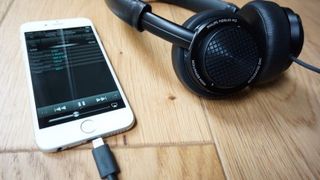TechRadar Verdict
Without a Lightning port, you're out of luck, but these groundbreaking headphones will unlock superior sound from your iPhone.
Pros
- +
High-res audio from your iPhone
- +
Dynamic, agile bass
- +
Smart all-digital design
Cons
- -
Locked to Lightning devices only
- -
No microphone
- -
Bit of a tight fit
Why you can trust TechRadar
Ditching the regular 3.5mm jack for a Lightning port renders these headphones inoperable with anything but late iPhones and iPads. And don't think you can just buy a Lightning-to-minijack adapter because there's no such thing.
Philips hasn't lost its corporate marbles though. Making an all-digital connection between source and speakers means you can listen to 48kHz high-resolution audio files from an iPhone for the first time. And even if you don't have any memory-sapping lossless FLAC files, the sonic advantages of bypassing a flaky analogue headphone port are clear. Crystal clear.
Audiophiles have been waiting for this inevitable evolution, but you might have expected to find the first Lightning connector on the end of a pair of Beats By Dre Studio following the acquisition last year by Apple. Maybe it was deemed too soon to lock in such a popular brand with a proprietary plug.

Meanwhile, the Sony MDR-1ADAC offers a similar high-res proposition by incorporating the same 24bit/192kHz DAC into the headphone itself – but with a regular analogue jack, even they couldn't extract high-res audio from an iOS device.
So Philips is the first to implement a Lightning connector, choosing its premium Fidelio brand and the proven M-series on-ear headphones to showcase it. But at £199 (US$300) and with no hope of plugging these exclusive headphones into anything else, only the most committed Apple loyalists need read any further.
Design
From the plug upwards, these look like plenty of other premium on-ear, closed back headphones. The steel band is wrapped in soft hand-stitched leather and the cups are filled with memory foam that hugs your ears. They clamp on pretty tight so they won't fall off when you're head banging, but you might find them a little tiring after an hour or so.
Of course, it's Apple's eight-pin Lightning connector that separates the Philips Fidelio M2L from every other pair of headphones on the market and it means there's no way of inputting an analogue signal. It also means the connector, one-metre cable and volume dial are unaffected by crosstalk and audio jitter that degrade an analogue signal.
So the digital stream is not converted by the iPhone's DAC, but a high-resolution 24-bit/192kHz DAC built into the headphones. That's why the volume dial and playback controls are located not half way up the cable, but on the right ear-cup. It's actually easier to operate from up here anyway, although sadly it leaves no room for an in-line microphone.
Performance
As mentioned, the Fidelio M2L are based fairly closely on the Philips Fidelio M1 and like their analogue counterpart, they achieve similar sonic characteristics. The soundstage is open, airy and revealing with a particularly descriptive and dynamic bass response. Using similar neodymium drivers and bass reflex system, it's not so surprising, but by directly comparing the two, the advantages of an integrated DAC and all-digital signal path are revealed.
The first thing you notice is there's no hiss, or noise from the cable or headphone controls at all, so the sound of the Philips Fidelio M2L is particularly clean and crisp. Secondly, the bass sounds even more agile and engaging than with the analogue Fidelio M1 headphones, and its particularly noticeable when listening to high-resolution files.

If you can track down the lossless FLAC file of Miss You by the Rolling Stones, which has a sample rate of 88.2kHz, its bassline has appreciably more bounce and depth when you switch directly between the M1s plugged into the iPhone's analogue headphone jack and the M2Ls hooked up by their Lightning connector.
iTunes doesn't allow you to port high resolution tracks to your iPhone 6 yet (even Apple's own ALAC files) but third-party iOS apps, like Onkyo HF Player, will let you import and play FLAC, ALAC and even DSD files in full high resolution. The catch is that they're downsized by the iPhone's DAC to fit through the headphone jack. Thanks to their Lightning connector however, the Philips Fidelio M2L can draw a pure digital signal, albeit downgraded a little to Lightning's 48kHz limit) and use their own 24-bit/192kHz DAC to deliver high-res audio to your ears.
Critics of high-resolution audio will say that there's no advantage in playing frequencies beyond the range of human hearing, but certainly those that you can hear appear to benefit from the absence of lossy heavy-handed compression. One answer is to directly compare a studio master with its compressed MP3 counterpart and decide for yourself. Thanks to Philips, you can now do that on your iPhone.
Verdict
Investing this much money in headphones that only work with your current phone might seem rash, but it really depends how committed you are to Apple. If you love your iPhone, there are real advantages in keeping everything digital. Eliminating crosstalk and interference from the cable and controls is one of them, while the ability to play lossless formats at 48kHz is another.
And given their superior build quality, the open soundstage and the thrilling bass response, these are surely the high-res headphones iPhone audiophiles have been waiting for.
Jim is a seasoned expert when it comes to testing tech. From playing a prototype PlayStation One to meeting a man called Steve about a new kind of phone in 2007, he’s always hunting the next big thing at the bleeding edge of the electronics industry. After editing the tech section of Wired UK magazine, he is currently specialising in IT and voyaging in his VW camper van.


